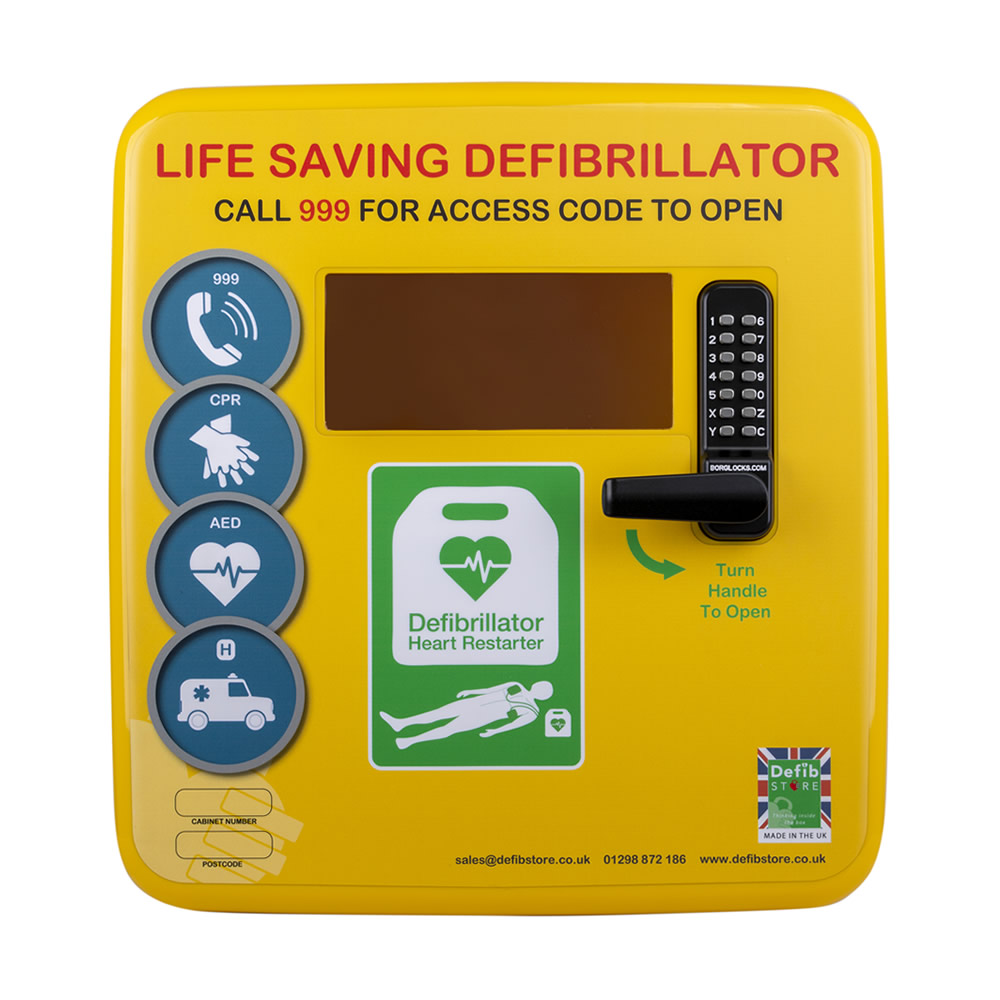- Home
-
Automated External Defibrillators (AEDs)
Shop by Type
 All Defibrillators
All Defibrillators
 Semi-Automatic Defibrillators
Semi-Automatic Defibrillators
 Fully Automatic Defibrillators
Fully Automatic Defibrillators
 Defibrillator Accessories
Defibrillator Accessories
 ECG Display Defibrillators
ECG Display Defibrillators
Shop by Application
 Schools & Education
Schools & Education
 Offices & Places of Work
Offices & Places of Work
 Sport & Leisure
Sport & Leisure
 Construction & Industrial
Construction & Industrial
 Public Access
Public Access
Related Information
Live Support 0800 612 6304 support@thedefibpad.co.uk Help & Advice FREE Delivery -
Defibrillator Pads & Batteries
Shop by Type
 All Pads & Batteries
All Pads & Batteries
 Adult Defibrillator Pads
Adult Defibrillator Pads
 Infant Defibrillator Pads
Infant Defibrillator Pads
 Training Defibrillator Pads
Training Defibrillator Pads
 Batteries & Chargers
Batteries & Chargers
Shop by Application
 Schools & Education
Schools & Education
 Offices & Places of Work
Offices & Places of Work
 Sport & Leisure
Sport & Leisure
 Construction & Industrial
Construction & Industrial
 Public Access
Public Access
Related Information
Live Support 0800 612 6304 support@thedefibpad.co.uk Help & Advice FREE Delivery -
Defibrillator Storage & Protection
Shop by Type
 All Storage & Protection
All Storage & Protection
 Carry Cases & Backpacks
Carry Cases & Backpacks
 Wall Brackets
Wall Brackets
 Storage Cabinets
Storage Cabinets
 Defib / AED ID Signs
Defib / AED ID Signs
Shop by Application
 Schools & Education
Schools & Education
 Offices & Places of Work
Offices & Places of Work
 Sport & Leisure
Sport & Leisure
 Construction & Industrial
Construction & Industrial
 Public Access
Public Access
Related Information
Live Support 0800 612 6304 support@thedefibpad.co.uk Help & Advice FREE Delivery -
Defib Training Units & Equipment
Shop by Type
 Defibrillator Training Units
Defibrillator Training Units
 Training Courses
Training Courses
 Training Defibrillator Pads
Training Defibrillator Pads
 Training Remotes
Training Remotes
 Training Manikins
Training Manikins
Shop by Application
 Schools & Education
Schools & Education
 Offices & Places of Work
Offices & Places of Work
 Sport & Leisure
Sport & Leisure
 Construction & Industrial
Construction & Industrial
 Public Access
Public Access
Related Information
Live Support 0800 612 6304 support@thedefibpad.co.uk Help & Advice FREE Delivery
defibrillators, accessories & advice
CALL OUR TEAM NOW 0800 612 6304
Also FREE from UK mobiles
FREE Delivery
on all orders
FREE Replacement Defib Electrode Pads After Use*
Live Online Customer Chat
Operators Available Now
Excellent Feedback - 4.9 / 5 Stars
Defibrillator Cabinets
Protecting defibrillators – indoors and outdoors

Commonly installed in public places, Automated External Defibrillators (AEDs), can save the life of a person having a cardiac arrest. Where they are installed inside (airports, railway stations, shopping centres, sports stadiums, gyms, sports facilities etc.), they can be wall mounted in a variety of cabinets; these protect the AED from dust and unauthorised tampering. While many cabinets are branded, they can usually be used universally.
Some have locks, while others are fitted with alarms. Those with locks are suited for locations such as sports centres where there is always somebody present who can unlock it - as time is of essence.
Where a key holder is not readily available, a cabinet with an alarm is an excellent alternative. The alarm is effective in two ways: if somebody is tampering with the device, the noise will warn them off; if there is a legitimate emergency, the alarm will alert others in the area who may be able to offer additional medical help or can call an ambulance.
Defibrillators in outdoor areas
Councils and other organisations are increasingly seeing AEDs as an essential element of first aid provision. As the number of publicly accessible installations expands, the likelihood of an AED being installed near you increases. Cabinets for storing defibrillators outside have to take into account a number of factors, though:
Security:
Some external cabinets will have alarms which will warn off potential thieves or vandals or attract help when used in legitimate emergencies. Others have code locks and display a phone number to be called to receive the code to open the lock. There is usually also a location code shown on the cabinet to help identify your location. All publicly accessible defibrillators should be registered with the emergency services.
Weather:
Key is to ensure that an outdoor cabinet is dust and waterproof. It should have a minimum weatherproof rating of IP65 (IP means ingress protection ratings). UV filters to help protect against direct and indirect sunlight are also a consideration for cabinets with glass panels.
Temperature:
Outdoor cabinets should be able to keep the AED at a temperature that will allow it to function successfully (above 5°C). To enable this, some outdoor cabinets have a thermostatically controlled heater inside that will be mains powered. External cabinets can be capable of operating at extreme temperatures (down to -25°C). Please note that all installations should be undertaken by a qualified electrician.
Visibility:
Some of the cabinets have LED lights to draw attention and to get people used to the location of the defibrillator. In general, defibrillator cabinets should stand out so that they can be easily spotted in case of emergency. Additional signage may be required.
It is desirable to keep a functioning landline telephone near the AED to ensure the emergency services can be contacted in the event of an incident.
Keeping a defibrillator operational
Once the cabinet and the AED have been installed, ongoing costs are minimal. An outside cabinet requires a tiny amount of electricity to power the thermostat and internal heater but this should run to only a few pounds a year.
The battery life of most AEDs generally lasts between two and seven years, or for a certain number of deployments. The electrode pads generally have a shelf life of two to three years at which point they will need to be replaced even if they have not been used. If they are used, they must also be replaced. The defib cabinets should be inspected regularly to ensure that they have not been used or been tampered with.























